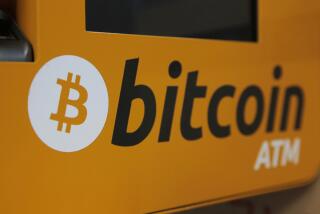Versatile ATMs Offer Both Convenience, Hazards to Consumers : Banking: The technology can now even handle investment transactions. But with innovation comes predators.
- Share via
NEW YORK — As automated teller machine, or ATM, cards get more and more versatile and convenient, the job of handling them wisely and safely becomes more and more important as well.
ATMs started out about a decade ago as a way to allow 24-hour banking, for deposits of checks and withdrawals of cash without the need to have a human teller involved in every transaction.
Since then their uses have multiplied. Many ATM cards now double as debit cards, with terminals in stores where consumers can use them instead of checks or cash at checkout counters to pay for goods of many kinds.
Thanks to nationwide and worldwide ATM networks, a card from a local bank, thrift or credit union now also can serve as a handy source of money for travelers in faraway places, making it unnecessary to carry large amounts of cash.
At some institutions, furthermore, they can even be used to invest money in, or withdraw it from, investments like mutual funds.
The number of uses seems certain to keep increasing, aided by continuing advances in technology. But with all their benefits, ATM cards require careful handling, especially with regard to security.
The machines where they are used are natural magnets for thieves, robbers, con artists and other predators looking for ways to breach the security of the system.
“At night, use ATMs that are well-lighted, with a good view of the surrounding car and pedestrian traffic,” counsels the Credit Union National Assn. “Try to have a friend accompany you.
“If anyone asks you to withdraw money from an ATM for any reason, leave at once and report the incident to police,” says the association.
As for the cards themselves, any lost or stolen cards should be reported as soon as possible to the institution that issued them. “The amount you’ll be responsible for depends on how quickly you report the loss,” notes the National Coalition for Consumer Education in a booklet published with MasterCard International and the MasterCard subsidiary Maestro U.S.A.
The personal identification number, or PIN, used with the card represents an especially vulnerable point.
“Never give your PIN to anyone,” says the consumer education group. “Do not write it on your ATM cash card or carry it in your wallet. Also, when selecting your PIN, avoid numbers and letters that can be easily associated with you.”
Protecting your PIN also means preventing people from learning it by watching you punch it into a machine. The eavesdropper needn’t be standing right next to you--it can be someone “shoulder surfing” with binoculars a long distance away.
Receipts produced by ATMs also need to be treated as security risks, not left behind carelessly at or near the machines.
Suggests the the Credit Union National Assn.: “Take your receipt with you, and keep it to compare against your monthly statement as a way to guard your budget and avoid fraud.”
It’s also only sensible to be mindful of fees that you may be charged, or may avoid, when you use an ATM card.
The card can save you on checking account charges. But depending on the policies of the issuing institution, it may also be costly to use in certain cases.
Says the Credit Union National Assn.: “Retailer fees should be displayed at the checkout counter. Fees charged by a financial institution must be disclosed to you at the time you receive your card.
“The charges will also appear on your monthly checking account statement. Ask about fees before using your ATM cash card.”
More to Read
Inside the business of entertainment
The Wide Shot brings you news, analysis and insights on everything from streaming wars to production — and what it all means for the future.
You may occasionally receive promotional content from the Los Angeles Times.










